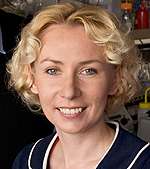Stem cell ruling puts researcher's project in limbo

(PhysOrg.com) -- Promising work by Joanna Wysocka, PhD, has been thrown into an uncertain limbo by a recent injunction suspending federal funding for human embryonic stem cell research.
Joanna Wysocka, PhD, has had a spectacular year. The young Stanford University School of Medicine stem cell researcher published her research in one of the world’s most respected scientific journals, won a top award from an international stem cell society and received the highest of scores on a National Institutes of Health grant proposal that promises to help children with a rare but devastating developmental disorder.
But like many other Stanford researchers, her work has now been thrown into an uncertain limbo by a recent injunction issued by federal Judge Royce Lamberth suspending federal funding for human embryonic stem cell research.
Irving Weissman, MD, director of the Stanford Institute for Stem Cell Biology and Regenerative Medicine, criticized the Aug. 23 ruling as “profound and disturbing,” and warned that the long-term impact of the ruling would be “a massive halt to most embryonic stem cell research in the United States.” The ruling also has at least one other Stanford researcher debating whether to embark on a stem cell research project.
Wysocka’s work is primarily focused on CHARGE syndrome, a congenital disorder that affects one in 10,000 children and subjects them to a host of potentially life-threatening complications. Her initial work on the syndrome’s mechanism was impressive enough to be published in Nature, one of the world’s most prestigious science journals. This year, in part based on this research, she was also given the 2010 Outstanding Young Investigator Award by the International Society for Stem Cell Research.
For Wysocka, an assistant professor of chemical and systems biology and of developmental biology, the injunction puts in doubt the NIH funding that seemed sure to come this year. Wysocka had applied for a large RO1 grant from the NIH to continue the work, and was delighted when the NIH rated her proposed project as more worthy than 99 percent of the proposals received.
“With my new-investigator status and the grant proposal score, I was confident that the application would be funded,” Wysocka said.
Then she heard about the Lamberth ruling, and the trajectory of her skyrocketing research took a steep dive. Her initial work was funded by a seed grant from the California Institute for Regenerative Medicine, but that grant has ended. “I am currently funding this project largely from leftovers of my start-up funds and relatively unrestricted junior investigator awards, but we need more money to continue,” Wysocka said.
The uncertainty surrounding her research is being duplicated around the country, in part due to the ambiguous nature of the Lamberth ruling. The legal decision focuses on the challenge to the Obama administration guidelines, which have been in force since March 2009. Those guidelines replaced the Bush administration guidelines, which allowed research on a limited number of human embryonic stem cell lines. The Lamberth injunction rejects the Obama administration guidelines, but the judge’s reasoning — that any human embryonic stem cell research necessarily requires the destruction of human embryos and therefore contravenes existing law — also seems to make it illegal to use federal funding even for research on cell lines that were OK’d by the Bush administration.
Hank Greely, the Deane F. and Kate Edelman Johnson Professor of Law and director of the Stanford Center for Law and the Biosciences, observed that the judge’s order stops the NIH from implementing not only the Obama guidelines, but may mean that all human embryonic stem cell research is ineligible for federal funding. “I’m sure the Department of Justice and the NIH are trying to figure this all out,” Greely said.
For now, NIH officials have said that researchers at universities who had already received funding for human embryonic stem cell work could continue their projects. However, the agency is freezing its consideration of new research proposals involving embryonic stem cells. Additionally, the NIH on Aug. 30 told researchers on the agency campus to halt all human embryonic stem cell research.
With the nation’s legal experts still struggling to determine the implications of the ruling, those with an MD or PhD instead of a JD are feeling pressure to take a conservative course. Some Stanford researchers are taking a second look at their plans to embark on research involving stem cells. Radiology professor Brian Rutt, PhD, who came to Stanford last year, is in the initial stages of creating advanced imaging methods for stem cells, but now questions that course of inquiry.
“This is a fairly new effort of mine, and I wouldn’t want to change my focus too quickly from conventional imaging research toward stem-cell-specific imaging if the prospects for future NIH funding are dim,” Rutt said.
Wysocka, like most stem cell researchers, is most concerned about the immediate future. One complication of her situation is that only one-third of her NIH research grant proposal is focused on human embryonic stem cells. Most of the proposed research involves frog embryos and induced-pluripotent stem cells, on which there are no federal funding restrictions. As it stands now, she said, it seems that a “mixed” grant with even a little human embryonic stem cell research cannot be funded and the ruling may affect the non-stem-cell aspects of her work as well.
She is awaiting clarification on the matter from the NIH.
















